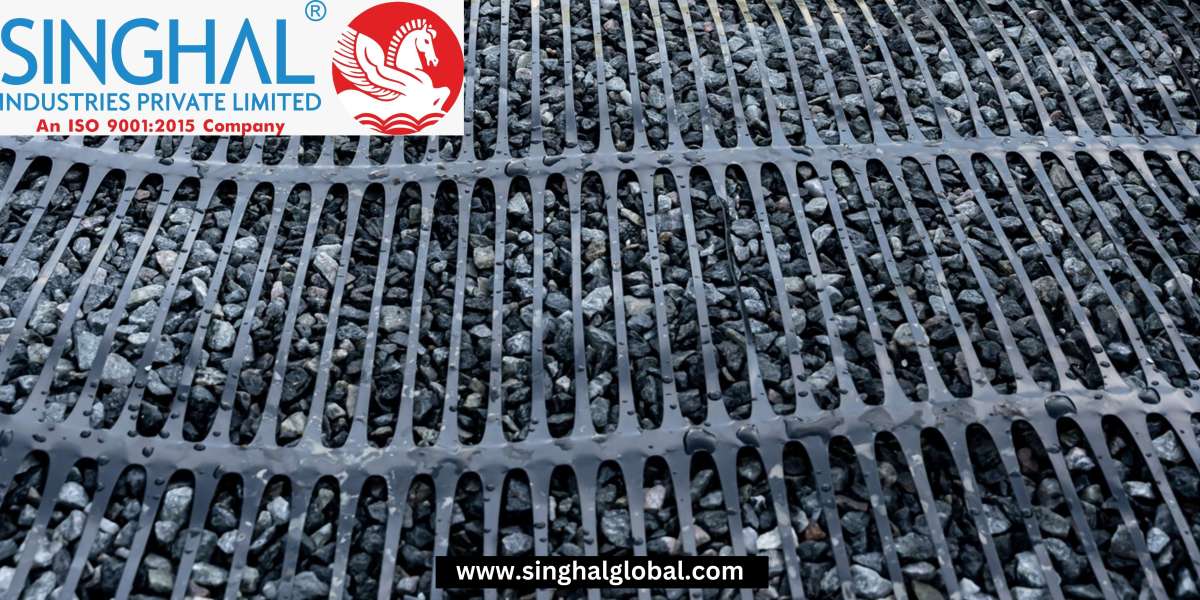Uniaxial geogrids are specialized geosynthetic products used primarily in soil reinforcement and stabilization. Hdpe uniaxial geogrid consist of polymer materials arranged to provide strength in a single direction, typically for bearing heavy loads and supporting soil structures. They are different from biaxial geogrids, which reinforce soil in two directions.
Uniaxial geogrids are essential in construction and civil engineering, especially for projects involving embankments, slopes, and retaining walls. The primary function of these grids is to stabilize soil, prevent erosion, and evenly distribute weight, making them ideal for high-load applications.
The Structure and Composition of HDPE Uniaxial Geogrid
HDPE Material Properties
High-Density Polyethylene (HDPE) is one of the most common materials used in uniaxial geogrids due to its durability and resistance to environmental factors. HDPE is resilient against chemical exposure, UV radiation, and mechanical stress, making it an excellent choice for long-lasting infrastructure solutions. HDPE-based geogrids provide tensile strength, allowing soil reinforcement without adding bulk to the construction project.
How HDPE Adds to Geogrid Strength
HDPE offers high tensile strength, which is crucial in supporting heavy loads and resisting deformation over time. This tensile capacity is what allows uniaxial geogrids to bear immense pressure without breaking down, even in challenging conditions. HDPE geogrids create a stable, cohesive layer within soil structures, allowing soil and other materials to lock into place and prevent shifting.
Benefits of Using Uniaxial Geogrids for Soil Reinforcement
1. Improved Soil Stability and Load Distribution
One of the primary benefits of uniaxial geogrids is their ability to enhance soil stability by distributing load pressures more evenly. This reinforcement minimizes soil shifting, ensuring a secure and steady foundation for construction. The geogrids absorb stress from various loads, which is particularly beneficial for roads and other heavy-duty applications.
2. Environmental Impact and Sustainability
Using uniaxial geogrids in construction can significantly reduce the need for other materials like cement or asphalt, which have a higher environmental footprint. HDPE geogrids are recyclable and can contribute to sustainable construction practices by reducing the amount of non-biodegradable materials needed.
3. Cost Efficiency in Construction
Because geogrids provide natural reinforcement, they reduce the amount of excavation and groundwork required, lowering construction costs. Additionally, the lightweight nature of HDPE grids simplifies transportation and installation, further contributing to project cost savings.
Applications of HDPE Uniaxial Geogrids in Construction
1. Roadways and Highway Infrastructure
Uniaxial geogrids are widely used in road construction to enhance subgrade stability, helping roads withstand heavy traffic loads. By reinforcing the soil under roadways, these geogrids prolong the life of road surfaces and reduce maintenance costs.
2. Retaining Walls and Embankments
In retaining walls and embankments, uniaxial geogrids provide additional structural integrity. The geogrids reinforce the soil, preventing wall collapse and reducing the risk of erosion. This support is particularly useful in areas with steep slopes or heavy rainfall.
3. Landfills and Waste Management Facilities
Uniaxial geogrids offer reliable solutions for reinforcing landfills and waste management areas by stabilizing the ground, preventing soil erosion, and containing waste materials. The durability and chemical resistance of HDPE make it ideal for these environmentally sensitive applications.
Comparison of Uniaxial Geogrids with Traditional Soil Reinforcement Techniques
Uniaxial geogrids stand out as a modern solution compared to conventional reinforcement methods like steel mesh or soil nailing. Geogrids are often more cost-effective and easier to install, with the added benefit of being resistant to rust and corrosion, unlike metal-based options.
Pros and Cons of Geogrids vs. Alternatives
While traditional methods may offer greater flexibility in certain projects, Uniaxial Geogrid India are generally faster and more economical to install. They provide sufficient reinforcement for most applications without the heavy machinery required for alternative techniques.
How to Select the Right Uniaxial Geogrid for Your Project
1. Key Factors to Consider
When choosing a geogrid, it's essential to consider factors like load-bearing requirements, environmental exposure, and expected lifespan. HDPE uniaxial geogrids are preferred for high-load applications and areas exposed to harsh weather due to their durability.
2. Choosing Based on Soil Type and Structural Needs
Soil type significantly influences the type of geogrid needed. Clay-based soils, for example, may require grids with higher tensile strength, while sandy soils may benefit from grids with larger apertures for better interlocking.
Installation Process for HDPE Uniaxial Geogrids
Proper installation of uniaxial geogrids is crucial to their effectiveness. The installation process typically involves clearing the site, preparing the subgrade, and unrolling the geogrid over the area.
1. Preparation and Site Assessment
Before installation, ensure that the site is level and free of debris. Accurate site assessment will help avoid issues later in the project and provide a clear view of soil conditions.
2. Installation Steps and Best Practices
Begin by laying the geogrid over the prepped site. Overlap sections as necessary, securing them with anchors or stakes. Follow the manufacturer’s recommendations for spacing and alignment to maximize load-bearing efficiency.
Maintenance and Durability of Uniaxial Geogrids
Ensuring the long-term performance of HDPE uniaxial geogrids requires minimal but essential maintenance, especially in heavy-duty applications like roads, embankments, or landfills. Here’s how to maintain and maximize the lifespan of these versatile materials:
1. Expected Lifespan and Environmental Resilience
HDPE geogrids are highly resilient to environmental factors like UV exposure, chemicals, and moisture. When installed correctly, they are known to last for decades, often outlasting alternative soil reinforcement materials. Routine inspections every few years help detect wear or unexpected stress, allowing for timely repairs.
2. Monitoring and Repair Tips
For projects with higher loads or varying environmental exposure, regular monitoring can help prevent minor issues from escalating. Most maintenance involves inspecting for areas of erosion or damage and applying repair methods recommended by the manufacturer, such as spot reinforcement.
Innovations and Future Trends in Geogrid Technology
As the construction industry moves towards sustainable practices, geogrid technology continues to evolve, incorporating new materials and designs for enhanced performance. The following trends highlight how uniaxial geogrids may advance in the future:
1. Advances in HDPE and Material Science
Researchers are exploring innovative HDPE formulations and alternative eco-friendly materials to boost geogrid strength, longevity, and environmental safety. For example, biodegradable options are being considered in environmentally sensitive areas where minimal long-term impact is crucial.
2. The Role of Geogrids in Sustainable Construction
With rising environmental awareness, the construction industry is increasingly adopting Uniaxial Geogrid for Soil Reinforcement technology to minimize resource usage and reduce the carbon footprint of large-scale infrastructure. From land reclamation projects to erosion control, uniaxial geogrids offer cost-effective solutions for sustainable development.
Conclusion: The Versatile Role of Uniaxial Geogrids in Modern Construction
Uniaxial geogrids, particularly those made from HDPE, have proven to be invaluable assets in civil engineering, road construction, and land reinforcement. With their unique load-bearing properties, durability, and eco-friendly potential, they are reshaping how construction projects approach soil reinforcement. From strengthening roadways to stabilizing landfills, uniaxial geogrids offer sustainable, cost-effective solutions that extend the lifespan of various structures and reduce environmental impact. As technology advances, these geogrids are set to become even more integral to sustainable construction, providing reliable performance across diverse applications.
FAQs
What factors should I consider when selecting a uniaxial geogrid?
Consider factors like load-bearing requirements, soil type, environmental exposure, and expected durability. These aspects influence the grid’s performance and suitability for your specific project.
Can uniaxial geogrids be used in waterlogged areas?
Yes, HDPE uniaxial geogrids are resistant to water and suitable for use in waterlogged areas. They are commonly used for soil reinforcement in areas prone to erosion or high moisture.
What installation precautions should be taken to prevent grid movement?
Ensuring a level, stable subgrade, and proper anchoring with stakes or weights during installation will minimize grid movement. Follow recommended overlap and securing guidelines for optimal stability.
How do geogrids contribute to construction sustainability?
By reinforcing soil and reducing the need for extensive excavation or additional materials, geogrids help lower resource consumption and energy use. They also allow for more sustainable soil and structure management.
Are there eco-friendly options for uniaxial geogrids?
Yes, recent innovations have introduced biodegradable materials and recycled HDPE options for geogrids, which minimize environmental impact and are suitable for temporary projects.








